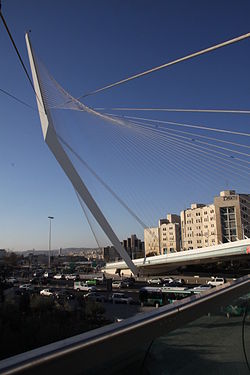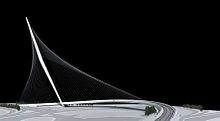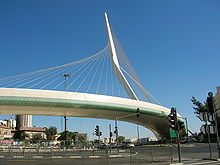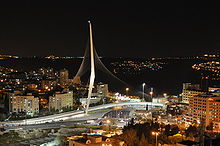- Jerusalem Chords Bridge
-
Jerusalem Chords Bridge 
Official name Gesher Hameitarim Carries Light rail (tramway) bridge / metro rail bridge[1] Crosses traffic intersection of Shazar Street and Herzl Boulevard[2] Locale Jerusalem, Israel Designer Santiago Calatrava Design Cable-stayed bridge Material steel (pylon and box girder)
reinforced concrete, Mitzpe yellowish limestone (abutments)
basalt cobblestone paving, glass, stainless steel (walkway)Total length 360 metres (1,180 ft)[2] Width 14.82 metres (48.6 ft)[2] Height 118 metres (387 ft) (pylon)
3.815 metres (12.52 ft) (deck)[2]Longest span 160 metres (520 ft)[2] Clearance below 5.5 metres (18 ft)[2] Construction begin 2005[2] Construction end 2008 Opened 2008-06-25[3] The Jerusalem Chords Bridge or Jerusalem Bridge of Strings (Hebrew: גשר המיתרים, Gesher HaMeitarim), also called the Jerusalem Light Rail Bridge is a cantilever spar cable-stayed bridge at the entrance to the city of Jerusalem, Israel designed by the Spanish architect and engineer Santiago Calatrava. The bridge is used by Jerusalem Light Rail's Red Line, which began service on August 19, 2011. Incorporated in the structure is a glass-sided pedestrian bridge enabling pedestrians to cross from Kiryat Moshe to the Jerusalem Central Bus Station. The bridge which cost about $70 million (NIS 246 million) was inaugurated on June 25, 2008.[4]
Contents
History
Calatrava first visited Israel for the opening of an exhibition of his works in Haifa in 1997. During that visit, he was invited to design a pedestrian bridge in Petah Tikva, which was opened in 2005. He was invited to Jerusalem by city engineer Uri Shetrit and former mayor Ehud Olmert,[5] who, according to Calatrava, challenged him to "do the most beautiful contemporary bridge".[6]
Construction of the Chords Bridge began in 2005, with an estimated cost of NIS 129 million, allready far higher than a first NIS 80 million forecast.[7]
Design and symbolism
The bridge was designed to add a defining visual element to the Jerusalem "skyline" at the entrance to the western city, and to carry a light rail system, expected to solve some of the city's traffic problems. For Calatrava the bridge is "also the excuse to create a major plaza, to give character and unity to this delicate place".[8]
Similar to Calatrava's Puente del Alamillo in Seville, Spain, the bridge makes use of an angled cantilever tower to absorb some of the load and reduce the number of cable stays needed. The bridge consists of a single pylon counterbalancing a 160 metre span with lengths of cables, making a dramatic architectural statement. While this is Calatrava's 40th bridge, it is the first he has designed to carry both train and pedestrian traffic.[9]
A striking feature of the bridge is a single 118-meter high mast supported by 66 steel cables[10] arranged in a parabolic shape which develops three-dimensionally in space,[8] making it the tallest structure in Jerusalem at the time of its completion. The exterior of the bridge is mostly clad in Jerusalem stone, with steel, glass and concrete detailing. Dubbed "Jerusalem's first shrine of modern design" by Time Magazine,[9] the bridge has become a tourist attraction but is not yet operative, with the light rail project several years behind schedule.[11]
The form of the bridge resemble a tent in the desert or a harp, with the cables as the strings, symbolising King David's harp, according to Calatrava,[12] others interpret the looming pylon as the bust of a long-necked bird, a human arm or an arrow caught in a bow.[13]
Criticism
The project has been criticized as an extravagant and costly solution to a problem that could have been solved by cheaper means,[10] the final cost of over $70 million exceeding the original budget more than twofold. The aesthetics of the bridge and its impact on Jerusalem has also sparked controversy.[14] Some say the bridge, situated at the city's crowded entrance, does not have enough space around it for people to appreciate its artistic merit, while others feel that the bridge is simply out of its element and question whether it fits visually in the city.[6] The bridge's dedication ceremony, a $500,000 extravaganza, also drew criticism, particularly as young female dancers, dubbed the "Taliban troupe",[15] were compelled to wear long skirts and cover their hair after ultra-Orthodox Jews threatened to disrupt the ceremony.[12]
See also
References
- ^ Jerusalem Light Rail Bridge at Structurae
- ^ a b c d e f g Personal e-mail with Santiago Calatrava, LLC
- ^ "Calatrava bridge opens in Jerusalem". Bridge Design and Engineering. 25 June 2008. http://654.pressflex.net/news/fullstory.php/aid/1504/Calatrava_bridge_opens_in_Jerusalem.html.
- ^ Lefkovits, Etgar (25 June 2008). "Jerusalem landmark inaugurated with gala". Jerusalem Post. http://www.jpost.com/Israel/Article.aspx?id=105530.
- ^ Zandberg, Esther (17 June 2004). "The builder of bridges". Haaretz. http://www.haaretz.com/culture/arts-leisure/the-builder-of-bridges-1.125445.
- ^ a b Kershner, Isabel (4 April 2008). "Grand bridge for a drab Jerusalem neighborhood". New York Times. http://www.nytimes.com/2008/04/02/world/africa/02iht-journal.4.11627091.html.
- ^ Kedmi, Sharon (20 January 2005). "Shapir, Eiffel win tender to build Calatrava bridge project". Haaretz. http://www.haaretz.com/print-edition/business/shapir-eiffel-win-tender-to-build-calatrava-bridge-project-1.147718.
- ^ a b "Santiago Calatrava, Light Rail Train Bridge, Jerusalem, Israel". arcspace.com. 21 July 2008. http://www.arcspace.com/architects/calatrava/light_bridge/light_bridge.html.
- ^ a b "Striking Chords in Jerusalem". Time Magazine. http://www.time.com/time/specials/2007/article/0,28804,1642444_1849541_1849538,00.html#ixzz0iWuABfDF.
- ^ a b "Discord at opening of Chords Bridge - Haaretz - Israel News". http://www.haaretz.com/hasen/spages/996244.html. Retrieved 2008-07-02.
- ^ "Going off the rails in Jerusalem". http://www.haaretz.com/hasen/spages/975689.html. Retrieved 2008-07-02.
- ^ a b The Associated Press (25 June 2008). "Jerusalem's Bridge of Chords - a new addition to city of ancient symbols". Haaretz. http://www.haaretz.com/travel/jerusalem-s-bridge-of-chords-a-new-addition-to-city-of-ancient-symbols-1.248468.
- ^ Volner, Ian (9 July 2008). "A Bridge, Yes, But to Where?". The Jewish Daily Forward. http://www.forward.com/articles/13730/.
- ^ "The bridge too far - or not far enough?". http://www.haaretz.com/hasen/spages/985708.html. Retrieved 2008-07-02.
- ^ Lefkovits, Etgar (13 November 2008). "Jerusalem Affairs: Giving new meaning to an undivided capital". Jerusalem Post.
External links
Categories:- Santiago Calatrava structures
- Buildings and structures in Jerusalem
- Bridges in Israel
- Cable-stayed bridges
- Railway bridges in Israel
- Bridges completed in 2008
Wikimedia Foundation. 2010.



